A Bird Eye's View
Two Diagonally Opposite Characters (Imam Hussain and Yazid)
"Imam Hussain"
Hussein ibn Ali
of the Ahl al-Bayt
of the Ahl al-Bayt
The Leader of Entire Humanity
Born: 3rd Sha‘bān 4 AH ≈ 8 January 626 CEDied: 10th Muharram 61 AH ≈ 10 October 680 CE
According to most of the reports, Husayn ibn Ali was born on 3 Sha'aban 4 AH/10 January 626 CE











Hussein Mosque in Karbala (1932)
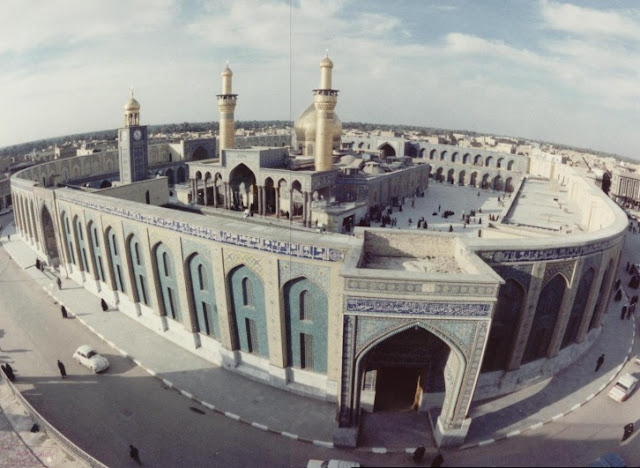






The Shrine of Imam Husayn's head in Damascus

The Zarih of Imam Husayn's head in Cairo

The place where Imam Husayn's head is kept, Umayyad mosque, Damascus

Believed by the Fatemids to be the burial place of Imam Husayn's head in Askelan, Israel
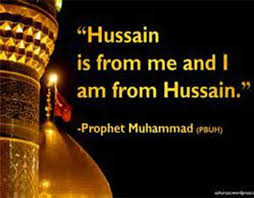

Moinuddin Chishti


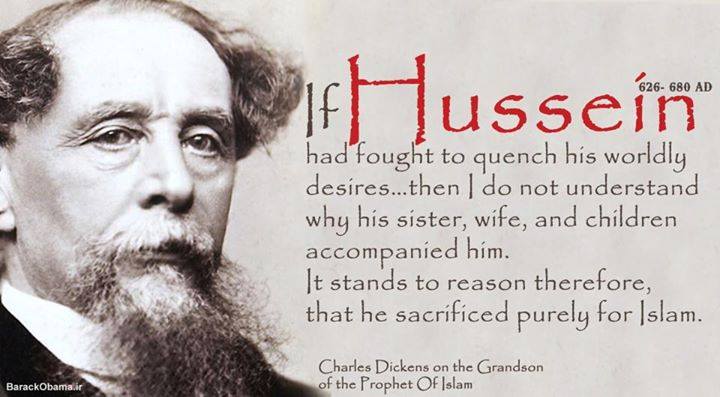
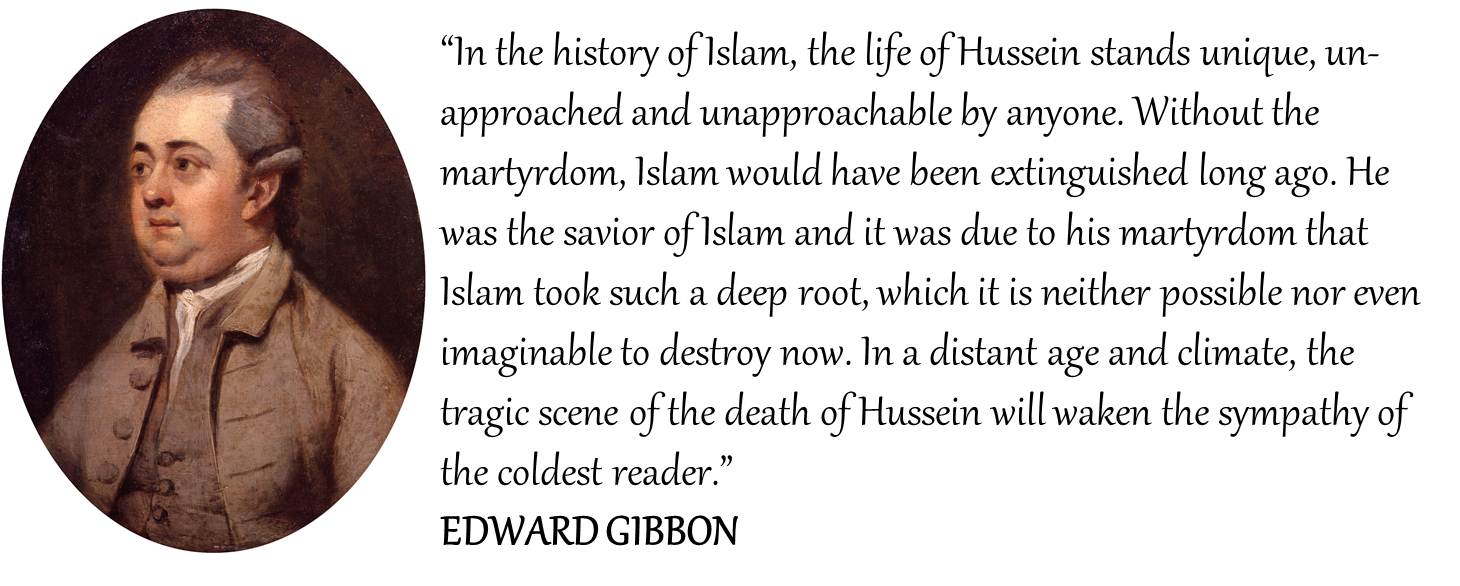


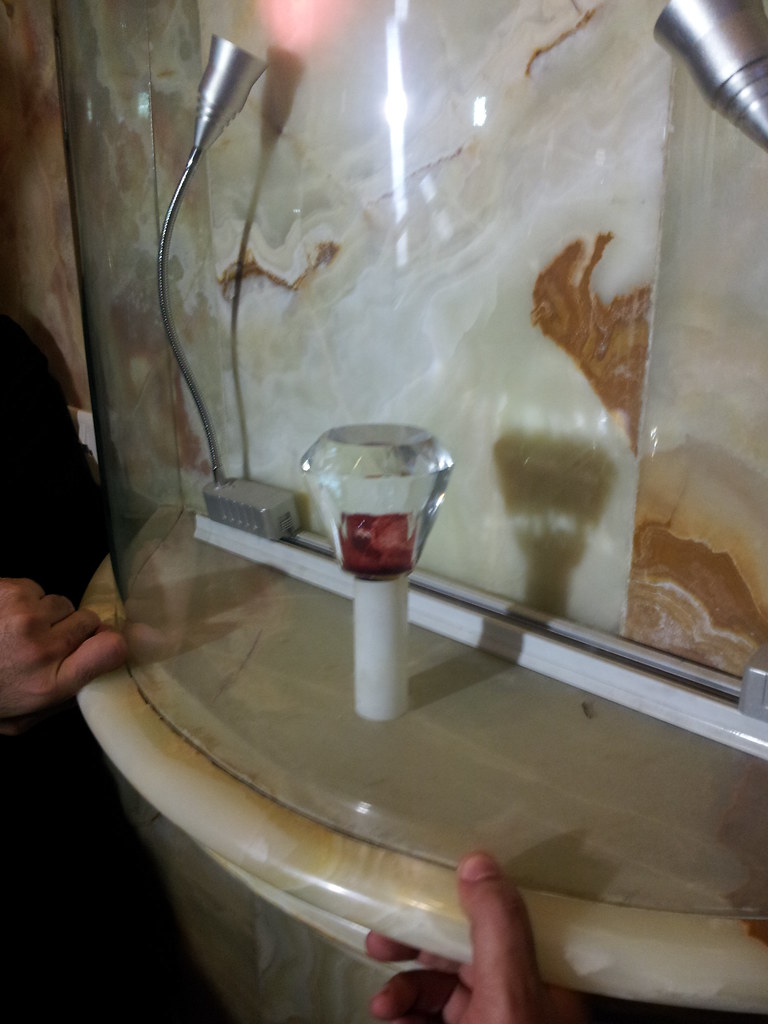




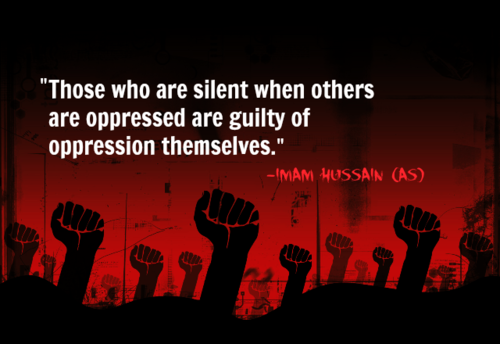

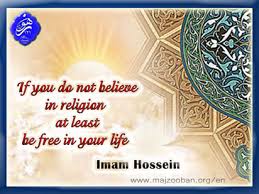
Yazid’s fear of Imam Husain (a.s) was so great that he sent a special emissary with a letter to al-Waleed commanding him to get the oath of allegiance from Imam Husain (a.s), Abdullah Bin Umar, Abdullah bin Az-Zubair, with a special stress on Imam Husain (a.s), and to kill them if they refused.
The Berbers launched an attack and drove Muslims from north Africa for a period. This was a major setback for the Muslims, because of this they lost supremacy at sea, and had to abandon the islands of Rhodes and Crete.

The reason for the the death of Yazid some said: He was drunk so much,in that state while dancing ,fell down upon his head and died.
Hind me kaash Hussain ibn Ali aa jaate
Toofan barpa hai garm haii maiidan-e-Karzaar


According to most of the reports, Husayn ibn Ali was born on 3 Sha'aban 4 AH/10 January 626 CE

Imam Husayn Shrine
The Shrine of Imam Husayn ibn ‘Alī (Arabic: مقام الامام الحسين) is one of the oldest mosques in the world and a holy site in the city of Karbalā, Iraq. It stands on the site of the grave of Imam Husayn ibn ‘Alī, the second grandson of Prophet Muhammad (PBUH), near the place where he was martyred during the Battle of Karbalā in 680 C.E.. The tomb of Imam Husayn ibn ‘Alī is one of the holiest places ‘asoutside of Mecca and Medina, and many make pilgrimages to the site. Every year, millions of pilgrims visit the city to observe ‘Āshūrā, which marks the anniversary of Husayn ibn ‘Alī's martyrdom.
The Umayyad and Abbasid caliphs prevented construction of the shrines and discouraged pilgrimage to the sites. The tomb and its annexes were destroyed by Abbasid caliph Al-Mutawakkil in 850-851 and pilgrimage was prohibited, but shrines in Karbala and Najaf were built by the Buwayhid emir 'Adud al-Daula in 979-80.
Two main roads lead the visitor to Karbala. One is from the Iraqi capital Baghdad, through Al-Musails, and the other is from Najaf.
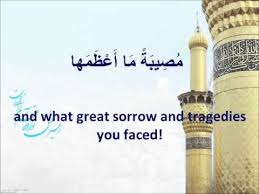
The Umayyad and Abbasid caliphs prevented construction of the shrines and discouraged pilgrimage to the sites. The tomb and its annexes were destroyed by Abbasid caliph Al-Mutawakkil in 850-851 and pilgrimage was prohibited, but shrines in Karbala and Najaf were built by the Buwayhid emir 'Adud al-Daula in 979-80.
Two main roads lead the visitor to Karbala. One is from the Iraqi capital Baghdad, through Al-Musails, and the other is from Najaf.










Hussein Mosque in Karbala (1932)
200 Years Before





The Shrine of Imam Husayn's head in Damascus

The Zarih of Imam Husayn's head in Cairo
The place where Imam Husayn's head is kept, Umayyad mosque, Damascus
Believed by the Fatemids to be the burial place of Imam Husayn's head in Askelan, Israel
Burial Place of Head of Hazard Imam Hussein (AS) Damascus (Syria)
Sword of Hazrat Imam-Hussain R.A
Muharram happens to be the first month of the Islamic
calendar and considered auspicious for the Muslims all over the world. The
tenth day of Muharram, called the Ashura is observed in the name of the month.
Hence it is called as 10 Muharram.
10 Muharram is observed to
commemorate the martyrdom of Imam Hussain ibn Ali (Hazrat Imam Hussain), "Leader of the Youth of the
Paradise", the grandson of the Islamic
prophet Muhammad (PBUH), who along with members of his family and close
friends at the Battle of Karbala in the year 61 AH (AD 680) died in the battle of Karbala
on the tenth day of Muharram in 61 AH(680 AD).
On one
side of the highly uneven battle were a small group of supporters and relatives
of Muhammad's grandson Husain
ibn Ali, and on the other was a large
military detachment from the forces of Yazid I, the Umayyad caliph.
Husain
and all his supporters were martyred, including Imam Husain's six months old
infant son, and the women and children were taken as prisoners.
Hussein bin Ali is credited with saving Islam from oblivion by offering timely
sacrifice to draw the line of demarcation between real Islam and the version
promoted by the Tyrant Yazid
This
story is not all too different from the crucifixion of Jesus in Christianity.
Four months, out of which
Muharram was one, was considered a non-fighting period.
Hurr was originally one of the commanders of Ibn Ziyad's army but changed allegiance to Husain along with his son, slave and brother on 10 Muharram 61, October 10, 680 AD
| Strength | |
|---|---|
| 100,000 | 70-150 (general consensus 110;including 6 month old baby). Note the common number '72' comes from the number of heads severed. |
| Casualties and losses | |
|---|---|
| 78 (according to Tabari) | All the men and Husain's baby son killed. |
Karbala is a city in Iraq, located about 100 km (62 mi)
southwest of Baghdad. Karbala is the capital of Karbala Governorate, and has an estimated population of 572,300
people (2003).
Geography
To the west of Karbala
is the Lake Milh (lake of salt), also known as Lake
Razazah. A one hour car drive south takes you to Najaf. An hour car drive to
the north-east takes you to Baghdad.
Karbala:
origin and meaning
According
to belief, the true meaning of the name Karbalā was narrated to Muhammad (PBUH) by the archangel Gabriel as being, "the land
which will cause many agonies (karb) and afflictions (balā).
Climate
Karbala experiences a
hot desert climate with extremely hot, dry summers and cool
winters. Almost all of the yearly precipitation is received between November
and April, though no month is truly wet.
Climate data for Karbala
|
|||||||||||||
Month
|
Jan
|
Feb
|
Mar
|
Apr
|
May
|
Jun
|
Jul
|
Aug
|
Sep
|
Oct
|
Nov
|
Dec
|
Year
|
Average high °C (°F)
|
15.7
(60.3)
|
18.8
(65.8)
|
23.6
(74.5)
|
30.6
(87.1)
|
36.9
(98.4)
|
41.5
(106.7)
|
43.9
(111.0)
|
43.6
(110.5)
|
40.2
(104.4)
|
33.3
(91.9)
|
23.7
(74.7)
|
17.6
(63.7)
|
30.78
(87.41)
|
Average low °C (°F)
|
5.4
(41.7)
|
7.0
(44.6)
|
11.2
(52.2)
|
17.1
(62.8)
|
22.5
(72.5)
|
26.3
(79.3)
|
28.8
(83.8)
|
28.2
(82.8)
|
24.3
(75.7)
|
19.0
(66.2)
|
11.6
(52.9)
|
6.9
(44.4)
|
17.36
(63.24)
|
Precipitationmm (inches)
|
17.6
(0.693)
|
14.3
(0.563)
|
15.7
(0.618)
|
11.5
(0.453)
|
3.5
(0.138)
|
0.1
(0.004)
|
0.0
(0)
|
0.0
(0)
|
0.3
(0.012)
|
4.1
(0.161)
|
10.5
(0.413)
|
15.3
(0.602)
|
92.9
(3.657)
|
Avg. precipitation days
|
7
|
5
|
6
|
5
|
3
|
0
|
0
|
0
|
0
|
4
|
5
|
7
|
42
|
The Imām, ‘Alī Zaynul ‘Ābidīn (A.S) narrated:
God chose the land of Karbalā as a safe and blessed sanctuary twenty-four thousand years before He created the land of the Ka‘bah and chose it as a sanctuary. Verily it (Karbalā) will shine among the gardens of Paradise like a shining star shines among the stars for the people of Earth.
In this regard, Imam Jafar Sadiq (A..S) narrates,
'Allah, the Almighty, has made the dust of my ancestor's grave - Imam Husain (a.s.) as a cure for every sickness and safety from every fear.'
'Allah, the Almighty, has made the dust of my ancestor's grave - Imam Husain (a.s.) as a cure for every sickness and safety from every fear.'
Muhammad (PBUH) is reported to have said that whoever loves them has loved him and whoever hates them has hated him.
Husayn from Me and I'm from Husayn" .A famous narration declares them the "Masters of the Youth of Paradise"
Other traditions record Muhammad (PBUH) with his grandsons on his knees, on his shoulders and even on his back during prayer at the moment of prostrating himself during their young age
Muhammad (PBUH) loved them and declared them as his Ahl al-Bayt very frequently.
The Qur'an has also accorded the Ahl al-Bayt an elevated position above the rest of the believers.
SHRINE:
Timeline
| Year | Event | |
|---|---|---|
| AH | CE | |
| 61 | 680 | October 10: Husayn is said to have been buried on this day. It was Bani Asad who, after the departure of Ahl al Bait, assembled at the grave of Imam Husayn. Historical accounts provide little light on the first builder of the Shrine. It is assumed that Bani Asad also the first, who erected a tent upon the grave of Imam Husayn. A Shaikh of Bani Asad lighted a candle at the grave of the Imam and planted a berry tree a few feet away from the side of the head of the grave, to indicate the grave of Husayn. |
| 65 | 684 | A mosque was built by Mukhtar ibn Abu `Ubayd ath-Thaqafi on the spot and a dome was created over the grave. Over the dome he fixed a green flag. Two entrance gates were made for the mosque. He also settled several families around the enclosure. |
| 132 | 749 | Another dome was erected over the mosque and additional two gates for entrance were made at the mausoleum during the reign of Abbasid Caliph as-Saffah. |
| 140 | 763 | During the reign of Caliph al-Mansur, the roof along with the domes were destroyed. |
| 158 | 774 | The demolished roof was rebuilt during the reign of Caliph al-Mahdi. |
| 171 | 787 | During the reign of Caliph Harun ar-Rashid, the mausoleum was destroyed and the Berry tree that stood besides the grave of Husayn was cut down. Even then people kept visiting the grave of Imam Husayn, guided by the traces of the ‘Tree of the Berry’, which covered the grave. Harun al-Rashid could not tolerate this, and ordered the tree to be totally cut off from the roots, with the intention to wipe out the sign of the grave of Husayn and stop the practice of visiting the grave. |
| 193 | 808 | The mausoleum was reconstructed during the reign of Caliph al-Amin. |
| 236 | 850 | Caliph al-Mutawakkil destroyed the mausoleum and ordered the nearby land, including the grave, to be ploughed. |
| 247 | 861 | Caliph al-Muntasir reconstructed the shrine with an iron pillar build a roof over the grave. Under instruction of Al Muntasir, new houses were built around the Shrines. |
| 273 | 886 | Once again the mausoleum was destroyed. |
| 280 | 893 | The shrine was rebuilt by the Alid council and two minarets were constructed on either side of the grave. Two entrance gates for the shrine were also constructed. |
| 307 | 977 | A sepulcher was constructed within the shrine using teak wood, by the Buwayhid emir‘Adhud ad-Dawlah. Surrounding galleries were also constructed. He also constructed the city of Karbala by making houses and the city boundary. ‘Imrān ibn Shahin at that time also constructed a mosque adjacent to the shrine. |
| 407 | 1016 | Fire destroyed the shrine. The vizier Hasan ibn Fadl rebuilt the structure. |
| 620 | 1223 | The sepulcher was renovated by an-Nasir li-Din Allah. |
| 757 | 1365 | The dome and walls of the shrine were reconstructed by Sultan `Uways ibn Hasan Jalayiri. He also raised the walls of the enclosure. |
| 780 | 1384 | The two minarets were reconstructed of gold by Sultan Ahmad ibn `Uways. The courtyard was also extended. |
| 920 | 1514 | The Safavid shah of Iran Ismail I, constructed a sarcophagus of inlaid glass work over the real grave. |
| 1032 | 1622 | Abbas Shah Safavi renovated the sarcophagus with brass and bronze and also the dome with Kashi tiles. |
| 1048 | 1638 | Sultan Murad IV whitewashed the dome. |
| 1155 | 1742 | Nadir Shah Afshar decorated the shrine and offered expensive gems to the treasury of the shrine. |
| 1211 | 1796 | Aghā Muhammad Shāh Qājār plastered the dome with pure gold. He also decorated the Min’ar and gold plated it. |
| 1216 | 1801 | Wahhabis attacked Karbala, damaged the shrine, and looted the sepulchre. |
| 1232 | 1817 | Fat'h ‘Alī Shāh Qājār reconstructed the screens by plating with silver. He also replated the dome with gold and therefore repaired the damage caused by the Wahhabis. |
| 1283 | 1866 | Nāsir ad-Dīn Shāh Qājār broadened the courtyard of the mausoleum. |
| 1358 | 1939 | Dr. Syedna Taher Saifuddin, of the Dawoodi Bohra community presented a set of solid silver screens with gold which were attached to the shrine. This set is made of 500 gold coins (each coin consisted 12 grams weight) and 200 thousand coins of silver, beautified with precious gems. |
| 1360 | 1941 | The western minaret was rebuilt by Dr. Syedna Taher Saifuddin. He spent a huge amount generously for the purpose of gold plating all the Min’ar. From top to bottom, pure gold was installed. |
| 1367 | 1948 | A road was built around the shrine by the then administrator of Karbala City, Sayyid Abd al-Rasul al-Khalsi. He also broadened the courtyard of the shrine. |
| 1411 | 1991 | Major damage to the shrine occurs as the city experiences violent reprisals by the army of Saddam Hussein after an uprising against his regime following the Persian Gulf War. |
| 1415 | 1994 | Repairs to the shrine from the damage done in 1991 are finally completed. |
| 1425 | 2004 | March 2: At least 6 explosions occurred during the ‘Āshūrā' commemorations, killing 85 people and wounding 230. |
| 1425 | 2004 | December 15: A bomb detonated near the gate of the shrine, killing at least 7 people and injuring 31 others. |
| 1426 | 2006 | January 5: Suicide bombers among the crowd between the two shrines, killed at least 60 people and injured more than 100. |
| 1428 | 2007 | April 14: A suicide attack 200m from the shrine killed at least 36 people and injured more than 160 others. |
| 1428 | 2007 | December: Construction work began on building a roof over the courtyard of the mosque, with hopes of creating a second floor and expanding the mosque. |
| 1429 | 2008 | March 17: A female suicide bomber detonated herself in the market near the shrine, killing at least 42 people and injured 58 others. |
| 1429 | 2008 | September 11: A bomb was detonated 800m from the shrine, killing one woman and injuring 12 others. |
| 1430 | 2009 | February 12: A bomb blast killed 8 people and wounded more than 50 others during the commemoration of Arba‘een. |
| 1431 | 2010 | Attacks aimed at pilgrims attending the commemoration of Arba‘een: February 1: A female suicide bomber detonated herself, killing 54 people and injuring more than 100 others. February 3: A bomb blast killed at least 23 people and injured more than 147. February 5: A double bomb-blast, or a combination of a bomb-blast and mortar attack killed at least 42 people and left 150 injured. |
Buried within the Mosque
The grave of Imam Husayn is found in the middle of the precinct, and is called the "Rawda" or "Garden"and it has several entry gates. The most famous one is called "Al-Qibla" or "Bāb al-Dhahab". When it is entered, one can see the tomb of Habīb ibn Madhāhir al-Asadī, to the right hand side. Habīb was a friend and companion of Imam Husayn since their childhood and was honored with martyrdom at the Battle of Karbalā.
Within the shrine of Imam Husayn can also be found a grave of all the 72 martyrs of Karbalā. They were buried in a mass grave which was then covered with soil to the ground level. This mass grave is at the foot of Imam Husayn's grave. As well, beside Imam Husayn's grave are the graves of his two sons: ‘Alī al-Akbar and the 6-month old, ‘Alī al-Asghar. Also buried within the mosque is Ibrāhīm (son of the seventhTwelver Imām, Mūsā al-Kādhim), who spent his life preaching about Karbalā.
Tribute to
Hazrat Imam Hussain(A.S)
In Medina, Saudi Arabia, the Shrine of Daughter of Prophet (PBUH) and Mother of Imam Hussain (AS)
In 1891 and destroyed in 1926
Allama Iqbal
Allama Iqbal's Beautiful Tribute to Hazrat Fatima Zahra (Daughter of Prophet PBUH and Mother of Hazrat Imam Hussain)
Hazrat Lal Shahbaz Qalandar
[1177- 1274 AD]
Reason for leaving Karbala and Arrival in Sindh:
One day Hazrat Lal Shahbaz Qalandar saw the King of Martyrs Imam-e-Hussain (A.S.), Imam-e-Hussain (A.S.) ordered Hazrat Lal Shahbaz Qalandar to go to Hindustan (Indo-Pak Subcontinent).

Qalandar’s famous Persian verses showing his devotion, love and honour for Imam Ali (A.S.), and are engraved on Hazrat Lal Shahbaz Qalandar’s shrine:
Haidariam Qalandaram Mastam
Banda-e-Murtaza Ali Hastam
Peshwa-e-Tamam Rindhanam
Keh Sag-e-Koo-e-Sher-e-Yazdanam
Banda-e-Murtaza Ali Hastam
Peshwa-e-Tamam Rindhanam
Keh Sag-e-Koo-e-Sher-e-Yazdanam
Translation:
I am Haidery (Relating to Haider, a second name for Imam Ali (A.S.) ibn-e Abu Talib (A.S.)), Qalandar (Free, Free of Boundaries, One who has Control on Dimensions) and Mast (Intoxicated with inspiration)
I am slave of Imam Ali Murtaza (A.S.)
I am leader of all saints
Because I am the dog, of the street, of “Allah’s Lion” (referring to Imam Ali (A.S.)
Sufi Saint Hazrat Khwaja Moinuddin Chishti Gharib Nawaz was born in Seistan, Iran in 1138 in a well-respected Syed family. His lineage goes to Amirul Momineen Hazrat Imam Ali ibn abi Talib through Imam Hasan Askari, the eleventh.
Khwaja Gharib Nawaz, Ajmer Sharif Dargah, Rajasthan India
Khawaja Ghareeb Nawaz’s (Ajmeir, India) immortal verses on the status of
Hazrat Imam Hussain (AS)
His poetry in praise of Imam Hussein ibn Ali is well known, specially the following verse:
Shah ast Hussain, Badshah ast Hussain
Deen ast Hussain, Deen Panah ast Hussain
Sardad na dad dast, dar dast-e-yazeed,
Haqaa key binaey La ila ast Hussain
And a rough translation -
Ruler is Hussain, Emperor is Hussain,
Faith is Hussain , guardian of faith is Hussain .
Offered his head and not the hand to Yazid.
Indeed, Hussain is the foundation of La-ilah
(the declaration that none but God is Absolute and Almighty)
Below Rubayee is inscribed in a stone in Ajmer Sharif:
Extract:
800 years before Hazrat Khwaja Moinuddin Chishty ( Sultan ul
Awliya ) has mentioned about the greatness of Hazrat Syedina Imam-e-Hussain ( Radi
Allahu Anhu ), beloved grandson of Hazrat Syedina Rasool Allah Sal-lal-lahu
Alaihi Wa Sallam. Hazrat Khwaja Moinuddin Chishty ( Rahamtullah Allaih ) has
also mentioned Yazid Lanati's name which is a solid proof and evidence
for all generations that Yazid was the enemy of Ahl-e-Baits and the family
of ( Grandsons of Beloved Prophet Sal-lal-lahu Alaihi Wa Sallam ) and
Yazeed was a great fasik who was took positon in unislamic way with force and
in only 3 years of his rule there was mass killings of sahaba e karam in
madina munawara and also yazeed's armies disrespected Kaabah and burnt Kaaba (
Baitul Haram ) killing many sahabas. This happens when a fasik al fajir sits on
the seat and changes shariah and sunnah.
Imam Hussain Mosque, Kuwait City

Gandhi Tribute Hazrat Imam Hussain(A.S)

- Indian leader, Mahatma Gandhi, said: “I learnt from Hussain how to attain victory while being oppressed.”
- Mahatma Gandhi writes:“My faith is that the progress of Islam does not depend on the use of sword by its believers, but the result of the supreme sacrifice of Hussain (A), the great saint.”
- “I have looked into the biography of Imam Al-Hussein, the great martyr of Islam, and I have scrutinized the tragedy of Karbala and reached the conclusion that if India wishes to achieve victory, it has to model after Al-Hussein.”
Charles Dickens (English novelist)




| Redness of the soil of Imam Hussain AS holy grave in the 10th of muharram (Ashura) |

Pt. Jawahar Lal Nehru
There is a universal appeal in his martyrdom. Hazrat Imam Hussein (a.s) sacrificed his all, but he refused to submit to a tyrannical government. He never gave any weight to the fact that his material force was far less in comparison with that of an enemy; the power of faith to his greatest force, which regards all material force as nothing. This sacrifice is a beacon light of guidance for every community and every nation”


Imam Hussain in International Ideology
British writer, Freya Stark, said:
“The Shiites throughout the Islamic world revive the memory of Al-Hussein and
his killing and mourn him the first ten days of the month of Muharram… There he
pitched his camp while his enemies surrounded him and held the water: the
details are as living to-day as then, 1257 years ago; nor can anyone with much
profit visit these Holy Cities unless he knows something of the story, for its
tragedy is built into their very foundation. It is one of the few stories I can
never read without weeping.”
The Afghani thinker Jamalul Deen Alafghani said,
“ there is
no Muslim unless he got love for Hussain in his heart who sacrificed everything
he have had for justice, and fighting renegades who aimed to tamper the
curriculum of Mohamed, but Allah disgraced them”
Faiz Ahmed Faiz (Pakistani Poet)
Raat aaee hai Shabbir pey yalgaar-e-bala hai
Sathi na koi Yar na gamkhwar raha hai
Monis hai to Ek dard kee Ghanghore Ghata hai
Mushfaq hai to Ek Dil key Dharakney kee sada hai
Tanhai kee, ghurbat kee, pareshani kee shab hai
Yeh Khana-e-Shabbir kee Wirani kee shab hai
Night has set in, manifold miseries have Shabbir chained,
No friend, no companion and no well-wisher has remained,
The dark clouds of pain and suffering, are but his soother,
And the throb of his wounded heart, is the only comforter,
It’s the night of a lonely being, stranger, stranded and molested,
It’s the night of Shabbir’s house, which is desolate and devastated.
Dushman kee sipah khwaab mein madhosh pari thee
Pal bhar ko kisi kee na idhar Ankh lagi thee
Har ek ghari Aaj qayamat kee ghari thee
Yeh Raat bahut Aal-e-Mohammad pey kadi thee
Reh reh key bukaa Ahl-e-Haram kartey they Aisay
Tham tham key Diya Aakri shab jalta hai jaisay
Fast Asleep, the enemy soldiers were senselessly lying,
But this side, non could even wink in a situation trying,
This day, each and every moment was mortifying,
To the progeny of the Holy Prophet, this night was most terrifying,
The house-folks bewailed so, at times but helplessly,
As if the snuffed-out candle, flickers at the night-end slowly.
Ek ghoshay mein Un Sokhta Samanon key Salaar,
Un Khak basar, Khaknuma Weeron key Sardaar,
Tasna lab-o-Darmanada- o-Majboor- o-Dil-Figaar,
Is shaan sey bhaithay they Shah-e-Lashkar- e-Ahraar,
Masnad thi, na khilaat thi, na khuddam kharey they,,
Haa tan pey jidhar dekhyee, So Zakham Sajay they
In a nook there was, the Commander of the deprived creatures,
The Chief of those uprooted and molested creatures,
Broken-hearted, exhausted, helpless and thirsty,
The Leader was sitting but with great dignity,
Neither was royal cushion, nor robe, nor were the attendants standing,
Multiple wounds were on his body, blood from each was oozing.
“The whole universe is sum up in the Human Being. Devil is not a monster waiting to trap us, He is a voice inside. Look for Your Devil in Yourself, not in the Others. Don’t forget that the one who knows his Devil, knows his God.” -Shams Tabrizi
Sayings of Imam Hussain (A.S)



Sayings
- Among the signs of ignorance is arguing with irrational people.
- Among the signs of a learned man is criticizing his own words and being informed of various viewpoints.
- Tolerance is man's ornament, keeping promises is a sign of nobility, and bonding with others is a grace.
- "Us Shaks Per Zulm Kerne
Se Mohtaat Raha Karo
Jis Ka ALLAH K Siwa
Koi Na Ho .."
- Hazrat IMAM HUSSAIN (R.A)
Videos
imam hussain (as) head's stone
Blood dripping out from the Stone Where Imam Hussain's Head Was Kept
Quotes about Imam Hussain
- “Hussain AS cannot be compared with rebels but with prophets, and Karbala cannot be compared with cities but with heavens, and Ashura cannot be compared with any historic events but with universal movements.”
- “With Hussain every defeat will be a victory, and without Hussain every victory will be a defeat.”
- “Hussain AS relied on the power of logic, while his enemy relied on the logic of power. When the power of his enemies was fallen, the logic of Hussain was prevailed, and his victory was eternal.”
- “His flag was torn but did not fall! His flesh was cut to pieces but he did not kneel! They beheaded his sons, brothers, and companions but he did not weaken! It is the legacy of faith in perfect manifestation.”
Yazid I
'Yazīd ibn Mu‘āwiya ibn Abī Sufyān Arabic: يزيد بن معاوية بن أبي سفيان (born 645; died 683), commonly known as Yazid I, was the second Caliph of the Umayyad Caliphate (and the first one by birthright). He ruled for three years from 680 CE until his death in 683 CE. Many Muslims condemn Yazid's rule as contentious and unjust while a section of Muslims, mostly living in Saudi Arabia, Pakistan and Egypt, maintain that Yazid was a just, noble, religious and administratively efficient ruler, (pl. see page 111-112 of book titled “Hazrat Muawiya and Historical Facts” by Maulana Mufti Taqi Usmani, published by “Idara Al-Mu’arif Karachi, Pakistan”). In violation of Islamic tradition and his own written agreement with Hasan ibn Ali, Muawiya I appointed his son Yazid as his successor, converting the Caliphate into a dynasty.
Yazid instructed his Governor Walid in Medina to force Husain ibn Ali to pledge allegiance to Yazid. Husain refused it and uttered his famous words that "Anyone akin to me will never accept anyone akin to Yazid as a ruler." Husain departed Medina on Rajab 28, 60 AH (680 CE), two days after Walid's attempt to force him to submit to Yazid I's rule. He stayed in Mecca from the beginnings of the Sha'ban and all of Ramadan, Shawwal, as well as Dhu al-Qi'dah.
It is mainly during his stay in Mecca that he received many letters from Kufa assuring him their support and asking him to come over there and guide them. He answered their calls and sent Muslim ibn Aqeel, his cousin, to Kufa as his representative in an attempt to consider the exact situation and public opinion.
Yazid’s fear of Imam Husain (a.s) was so great that he sent a special emissary with a letter to al-Waleed commanding him to get the oath of allegiance from Imam Husain (a.s), Abdullah Bin Umar, Abdullah bin Az-Zubair, with a special stress on Imam Husain (a.s), and to kill them if they refused.
Kufa, a garrison town in what is now Iraq, had been Caliph ‘Alī's capital and many of his supporters lived there. Husayn ibn Ali received many letters from the Kufans expressing their offer of support if he claimed the caliphate. On the way, he received the report of Muslim ibn Aqeel's death at the hands of Yazid's men and the apathy and indifference displayed by the people of Kufa.
The complications of Yazid's accession to the Caliphate didn't end there. Many Sahaba and fellow Muslims refused to give their oath of allegiance to Yazid
During the caliphate of Yazid, Muslims suffered several setbacks.
The Berbers launched an attack and drove Muslims from north Africa for a period. This was a major setback for the Muslims, because of this they lost supremacy at sea, and had to abandon the islands of Rhodes and Crete.
Death
Yazid I died at the age of 38. He ruled for 3 years. Yazid I was succeeded by his son Muawiyah II. On his death Yazid I was burried in Damascus. Most people believe his grave no longer exists while others believe that his grave is located in a small street near Omayyad Mosque without any mark or distinction
Yazid had a passion for music and alcohol. He always had a hangover in the morning due to his heavy drinking from the night before. Some historians claim that he died due to one of his pets actually biting him while he was playing with it.
Yazid had a passion for music and alcohol. He always had a hangover in the morning due to his heavy drinking from the night before. Some historians claim that he died due to one of his pets actually biting him while he was playing with it.
What Happened After the Incident of Karbala
Incidence of Karbala is the biggest tragedy in the history of Islam when the Hussain, grandson of last Prophet Muhammad (Peace be upon him) was murdered by those who also claimed to be the Muslims and the followers of the Prophet Muhammad (Peace be upon Him). Hussain was the beloved grandson of last Prophet Muhammad (Peace be upon Him). The tragedy of Karbala shook the foundations of the empire of Omayyad.
There were certain villains in the tragedy of Karbala e.g. Yazid, Shimar, Ibn Ziad and Omer bin Saad but None of those villains taking part in the holocaust at Karbala was able to escape the divine retribution.
Soon after Yazid’s death, who was the ruler at the time the incidence of Karbala occurred, Kufa fell into the hands of Mukhtar. His hand fell very heavily on the treacherous people of Kufa. There was a ruthless hunt for Hussain’s murderers, all of whom perished. The infamous Shimar, who murdered Hussain at Karbala battle field tried to escape but was caught. He was butchered and the dead body torn to pieces by hungry dogs.
Omar bin Saad, who was the commander of the forces of Yazid's Army was slain along with his son.
The greatest villain of all, Ibn Zaid, the Governor of Kufa at the time of incidence of Karabala, fell fighting against Mukhtar’s troops. His head lay before Mukhtar in the same Government House where only a few years before Hussain’s head lay before him.
The heads of Ibn Zaid and Ibn Saad were sent to Imam Zainul Abedin (A.S).
Hussain’s prophetic words, uttered a little before he was slain proved literally true.
Al-Mukhtar
al-Mukhtār ibn Abī ‘Ubayd Allah al-Thaqafī (Arabic: المختار بن أبي عبيد الله الثقفي) (622 CE - 687 CE)(Also Mukhtar bin Abu Ubaid) was an early Islamic revolutionary who led an abortive rebellion against Umayyad Caliphs after the death of Husayn ibn Ali at the Battle of Karbala
al-Mukhtar al-Thaqafi's tomb
Dreadful Crimes of Yazid ibn Muawiya
The Army of Yazid Set Ablaze and Destroyed Holy Kaaba
After supressing and plundering people of Madinah, Muslim ibn Aqabah started towards Makkah to crush Abdullah ibn Zubair.
Finally Hasin ibn Namir took the leadership of the Syrian Yazidi army and attacked Makkah.When Abdullah ibn Zubair took refuge in Masjid al- Haram and Kaaba.They stoned Kaaba with catapult war machine'and with cloth in kerosene oil and what ever inflammable in hand ,they threw upon upon so that Holy Kaaba was burnt and demolished.
It is narrated that the Syrian army commander ordered to hit the Holy Kaaba daily with ten thousand stones.
In the meantime as the Syrian army was attacking Holy Kaaba and destroying the holy place , Allah Almighty gave Yazid no chance and took away his life.He was still under the age of forty.
Yazid in the period of only three years caliphate committed heinous crimes.In his first year of rule he martyred Sayyid ush- Shuhada Imam Husain(A.S.) and captivated his whole family . In his second year of rule allowed his army to kill, loot and transgress the chastity of women in the holy city of Madinah.
In the third year of his rule he set ablaze the Holy Kaaba and demolished the holy place.
In the third year of his rule he set ablaze the Holy Kaaba and demolished the holy place.
The reason for the the death of Yazid some said: He was drunk so much,in that state while dancing ,fell down upon his head and died.
Others said: A bedouin Arab in desert,when Yazid got alone in chase of hunt. He introduced himself to Arab who got furiated and said: You are the murderer of Husain ibn Ali and the Arab killed Yazid on the spot.His body was buried in 'Bab Saghir" in Damascus. Now that place is changed into rubbish heap.
Tribute to
Hazrat Imam Hussain(A.S)
A tribute by Hindu Poets
Hind me kaash Hussain ibn Ali aa jaate
Choomte un ke qadam palke bichhate Hindu
Anch Ahmad ke nawase pe naa aane dete
Waqt padta jo koii sir bhii katate Hindu
- Bhuvnesh Chandra Sharma “Bhuvan” Amrohi
Toofan barpa hai garm haii maiidan-e-Karzaar
haii qatil.o me mahve fugha.n ek shahsawar
ibleesiyat iidhar haii, udhar insaan ka waqar
tanha Hussain or yaziidi kaii hazaar
aii gardish-e-zamaana thahar zaraa yahi.n
aiisi misal phir na milegi tujhe kahiin
:- Prof. Jagannath Azad
Karbala me ek bahana tha Hussain ibn Ali
lene waale ne liya thaa imtahan-e-Mustafa
:- Ram Bihari Lal 'Saba"
Baad marne ke bhii matam kii sada aati rahii
log hairat se meri chitaa ko dekha kiye
:- Chandra Shekhar Saxena.
Khuld uskii haii, khayba.n uska, Kausar us ka haii
Jis ko ulfat haii Vilayat aal-e-Payamber ke saath
:- Gauhar Prasad Nigam "Vilayat" Gorakhpuri.
Nazar aa jatii haii bazm-e-azaa se rah jannat kii
Shaheed-e-Karbala ke gham me jab rokar nikalte hai.n
:-Munshi Lakhman Narayan "Sakha"
Ab na samjhna mujhe sab ne wali likkha haii
mere maathe par Hussain Ibn Ali likkha haii
:- Mahendra kumar "Ashq"
Descendents of Imam Hassan (The Elder Brother of Imam Hussain)
Imam Hasan’s (AS) 3 sons,
- Qasim,
- Abdullah and
- Hasan-e-Muthanna,
were in Kerbala and took part in the Jihad with their uncle Imam Hussain (AS). Qasim and Abdullah died of their wounds but Hasan-e-Muthanna survived. He was among the wounded and was taken out alive by the Banu Asad Tribesmen. They treated his wounds and once he was better he returned back to Madinah. It appears that he stayed with the Banu Asad for over a year and when the family of the Prophet were released from captivity and returned to Kerbala he joined the caravan and returned with them to Madinah after the Arabeen in the year 62 Hijri. He was about 17 years old at that time. Later, he married Imam Hussain ‘s (AS) daughter Fatima Sughra. It is from this marriage that the descendants of Imam Hasan (AS) take their line in the family tree.
Hasan-e-Muthanna’s son Abdullah had four sons,
- Muhammad Nafse Zakiyya,
- Ibrahim ,
- Sulaiman and
- Idris.
Nafse Zakiyya rose against Mansur the 2nd Abbasid Caliph and received martyrdom, in the year 142 Hijri, 762 AD.
Ibrahim fought Mansur in Baghdad and was martyred. This was in 143 Hijri 763 AD.
Two other great grandsons of Imam Hasan, Sulaiman and Idris migrated to Iran and Tunisia respectively.
Descendents of Imam Hasan from Idris flourished in North Africa and brought Islam in the Maghrib. Idrisids are traditionally regarded as the founders of the Moroccan state.
From Sulaiman, who settled in Kirman, many of his descendents spread Islam in Persia and some of them later migrated to India.
A famous saying of Imam Hasan is:
“ In regard to the world be as if you were going to live forever. With respect to the Hereafter, be as if you were going to die tomorrow.”
Holy Shrine of Imam al-Reza
Mashhad – Iran
360 Degree views
Watch (Click Here)
Inside Imām Husayn Mosque (before the renovations in 2008)
Imām Husayn Mosque (before the renovations in 2008)
Entry gate to the grave of Husayn within the mosque
Imām Husayn Mosque (before the renovations in 2008)
Entry gate to the grave of Husayn within the mosque
Martyrdom and popularity
Karbalā was at first an uninhabited place and did not witness any constructional activity, although it was rich in water and its soil fertile.
Despite many attempts by successive rulers, such as Al-Rashīd and Al-Mutawakkil, to put a restriction on the development of this area, it has nonetheless spread with time to become a city.
Buried within the Mosque
The grave of Imam Husayn is found in the middle of the precinct, and is called the "Rawda" or "Garden"and it has several entry gates. The most famous one is called "Al-Qibla" or "Bāb al-Dhahab". When it is entered, one can see the tomb of Habīb ibn Madhāhir al-Asadī, to the right hand side. Habīb was a friend and companion of Imam Husayn since their childhood and was honored with martyrdom at the Battle of Karbalā.
Within the shrine of Imam Husayn can also be found a grave of all the 72 martyrs of Karbalā. They were buried in a mass grave which was then covered with soil to the ground level. This mass grave is at the foot of Imam Husayn's grave. As well, beside Imam Husayn's grave are the graves of his two sons: ‘Alī al-Akbar and the 6-month old, ‘Alī al-Asghar. Also buried within the mosque is Ibrāhīm (son of the seventhTwelver Imām, Mūsā al-Kādhim), who spent his life preaching about Karbalā.

A Quran attributed to Imam Hussain ibn Ali, from over 1300 years ago

Khema-gah, Memorial at Imam Husain Camp location, Karbala
Main Reasons of Happening of Karbala Incident
- Muslim forgot the Saying of Holy Prophet
GHADIR-E-KHUMM
Ghadir is on the way from Mecca to Madina. While returning from Mecca to Madina, after the last hajj, along with his companions, the Holy Prophet (S.A.W.) broke the journey at a lake, 3 miles away from Al-Johfa. He (S.A.W) halted at midday in a wayside tract of barren land with no shade other than that provided by a few acacia trees. A small lake is called as Ghadir in Arabic, so this place is known as Ghadir-e-Khumm. The name Ghadir is no longer in use.
+Roza+e+Hazrat+Imam+Hussain.jpg)







+en+Karbala-13_0.jpg)








.jpg)






















Bullion Exchanges is a trusted Precious Metals Retailer located in the heart of New York City's Diamond District.
ReplyDeleteBullion Exchanges have a wide inventory of items including, precious metals that range from the gold and silver to platinum & palladium.
They are offering a massive selection of products appealing to first time buyers and for established investors.